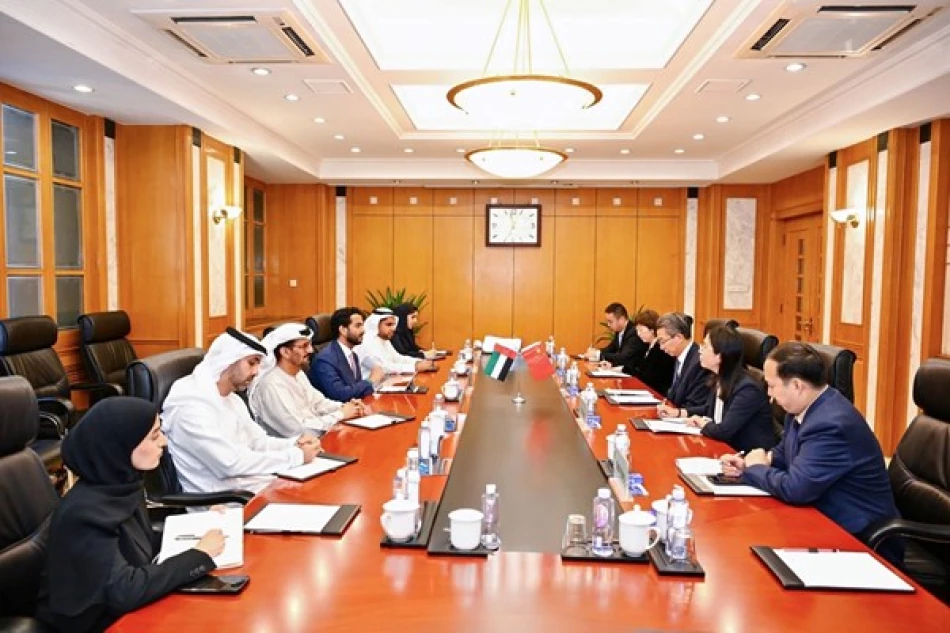
UAE and China Explore Expanding Economic and Investment Ties
UAE-China Economic Partnership Enters New Phase as Tourism and Trade Ties Deepen
The UAE is positioning itself as China's premier Middle Eastern partner through an ambitious expansion of bilateral cooperation spanning tourism, intellectual property, and emerging technologies. With over one million Chinese tourists visiting the Emirates in 2024 and Chinese business licenses surging 18% year-over-year, the relationship signals a strategic pivot that could reshape regional economic dynamics and challenge traditional Western-dominated trade corridors.
Tourism Emerges as Economic Bridge Between East and West
Abdullah bin Touq Al Marri, UAE Minister of Economy and Tourism, recently concluded three high-level bilateral meetings with senior Chinese officials, including Culture and Tourism Minister Sun Yeli, highlighting tourism as a cornerstone of the expanding partnership. The numbers tell a compelling story: the UAE now hosts over 350,000 Chinese residents and welcomed more than one million Chinese tourists in 2024 alone.
This tourism boom is supported by robust aviation connectivity, with 147 weekly flights linking the two nations—117 passenger flights and 30 dedicated cargo routes operated by UAE carriers. This infrastructure positions the Emirates as China's gateway to Africa, Europe, and the broader Middle East, leveraging Dubai and Abu Dhabi's status as global aviation hubs.
Strategic Timing Amid Global Tourism Recovery
The UAE's focus on Chinese tourism comes at a critical juncture. As China gradually reopens post-pandemic, destinations worldwide are competing fiercely for Chinese travelers—historically among the world's highest-spending tourists. The Emirates' success in capturing this market reflects both its visa liberalization policies and its appeal to Chinese preferences for luxury experiences, shopping, and cultural diversity.
Business Ecosystem Expansion Signals Long-Term Commitment
Perhaps more significant than tourism figures is the dramatic growth in Chinese business presence. By July 2025, nearly 16,500 Chinese business licenses were active in UAE markets—an 18% increase from the previous year. This expansion spans multiple sectors, from traditional trade and logistics to emerging technologies and renewable energy.
The partnership with the China Council for the Promotion of International Trade (CCPIT) suggests a coordinated effort to channel Chinese investment into what both nations term "new economy" sectors. This likely includes artificial intelligence, fintech, clean energy, and advanced manufacturing—areas where both countries are making substantial investments.
Intellectual Property Cooperation: A Strategic Differentiator
The inclusion of intellectual property discussions with China's National Intellectual Property Administration (CNIPA) represents a sophisticated approach to bilateral relations. Unlike purely transactional trade relationships, IP cooperation indicates the UAE's ambition to become a regional hub for innovation and creative industries.
This move mirrors successful strategies employed by Singapore and Switzerland, which built thriving economies by positioning themselves as trusted intermediaries for IP-intensive industries. For the UAE, this could mean attracting Chinese tech companies seeking regional headquarters while also facilitating Western firms' entry into Chinese markets.
Geopolitical Implications and Market Opportunities
The deepening UAE-China partnership occurs against a backdrop of shifting global trade patterns. As US-China tensions persist and supply chains diversify, the UAE is positioning itself as a neutral, business-friendly alternative for companies seeking to maintain relationships with both East and West.
For investors, this trend suggests several opportunities. UAE-based logistics and hospitality companies stand to benefit from increased Chinese business activity. Real estate markets in Dubai and Abu Dhabi may see continued Chinese investment, particularly in commercial properties. Additionally, the focus on "new economy" sectors could create joint venture opportunities in renewable energy and technology.
Competitive Positioning Against Regional Rivals
The UAE's success in attracting Chinese investment and tourism puts pressure on regional competitors like Saudi Arabia and Qatar, both of which are pursuing similar strategies. However, the Emirates' established infrastructure, regulatory framework, and cultural openness provide significant advantages in capturing Chinese business and leisure travelers.
The aviation connectivity alone—147 weekly flights—demonstrates the UAE's logistical superiority over regional rivals and positions it as the natural choice for Chinese companies seeking Middle Eastern operations bases.
Long-Term Strategic Vision
The UAE's National Tourism Strategy aims to establish the country as the world's leading tourism destination by the next decade. The Chinese market appears central to this ambition, given China's growing middle class and increasing propensity for international travel.
Beyond tourism, the focus on emerging technologies and intellectual property suggests the UAE is building a knowledge-based economy that can complement China's manufacturing prowess while serving as a bridge to Western markets. This positioning could prove particularly valuable as global trade becomes increasingly regionalized and companies seek neutral jurisdictions for international operations.
The 18% growth in Chinese business licenses indicates this strategy is already yielding results, with the UAE successfully attracting not just Chinese tourists but also long-term business investment across multiple sectors.
Most Viewed News

 Layla Al Mansoori
Layla Al Mansoori






